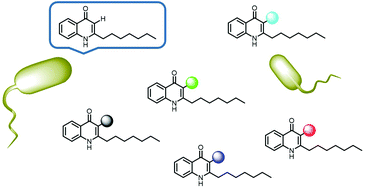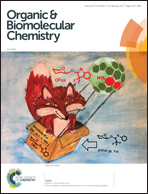The requirements at the C-3 position of alkylquinolones for signalling in Pseudomonas aeruginosa†
Abstract
The ‘perfect storm’ of increasing bacterial antibiotic resistance and a decline in the discovery of new antibiotics, has made it necessary to search for new and innovative strategies to treat bacterial infections. Interruption of bacterial cell-to-cell communication signalling (Quorum Sensing), thus neutralizing virulence in pathogenic bacteria, is a growing area. 2-Alkyl-4-quinolones, HHQ and PQS, play a key role in the quorum sensing circuitry of P. aeruginosa. We report a new set of isosteres of 2-heptyl-6-nitroquinolin-4-one, with alterations at C-3, and evaluate the key structural requirements for agonistic and antagonistic activity in Pseudomonas aeruginosa.


 Please wait while we load your content...
Please wait while we load your content...